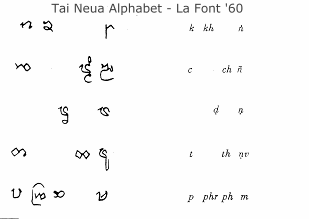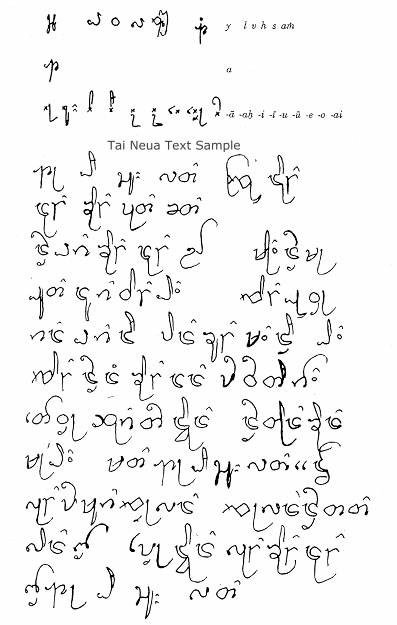| Tai Dehong/Neua/Nüa or Dehong Tai is a member of the Tai
language family, which is sometimes divided into three branches. In this tripartite
scheme, Dehong is placed into the Southwestern Branch. However, Professor Luo
Yongxian, whose introduction to A Dictionary of Dehong, Southwest China (1999)
appears on this website, has proposed a fourth division of the family, Northwestern Tai,
in which Dehong would be placed. He points out that Dehong has more in common with
the Tai languages of India than with the other Southwestern Tai languages, and that the
differences are sufficiently different to warrant this new division. One reason for
the marked difference can be explained in geographical terms. These languages lie to
the west of the Salaween River, and this barrier to communication might have proven over
time to promote isolation sufficient enough to account for much of the linguistic changes
these languages have undergone and that are still taking place at the farthest reaches of
the Tai family towards the northwest. In his dictionary introduction (p.xiv), Luo
declares that the alernations of consonants, vowels, and tones, which are numerous and
thefore remarkable, are an indication of ongoing sound changes in the area. It would
be interesting to know what the causes of these multiple perturbations are. In 1999 Edward Robinson presented a paper at the International
Conference on Sino-Tibetn Languages and Linguistics in Paris with the title "Features
of Proto-Nüa-Khamti." Using the comparartive method, he concluded, like Luo
Yongxian, that Tai Neua does indeed fall in line with the Tai languages of India, the
principal exponent being Ahom. "Tai Nua, Tai Mao, and Tai Kamti share five
sound correspondences which support a genetic grouping of these languages," as
follows: *khw > kh and *kw > k; Proto A Tones split along the
lines of 1-23-4; A23 = B4; * E
> e and * O > o in open
syllables; *?b > m. He points out that in both Tai Neua and Tai Mao /n/ merges
with /l/. In his language tree diagram, he indicates that Proto-NK and Tai Ahom
branch off from a Proto-Ahom-NK parent.
In an article entitled "Les Ecritures 'Tay du
Laos" published in Bulletin de l'Ecole Francaise d'Extreme-Orient (Tome L,
Fasc.1, 1960 by EFEO, Paris), Pierre-Bernand Lafont included a section on "Lecriture
'Tay Neua," based on a community of 25,000 Tai Neu speakers in the northern Lao
province of Hua-Phan and another group of 10,000 in Xieng-Khuang. He adds that there
are Tai Neua living along the Nam Lik and Nam Nhiep rivers in Vientiane province. A few
villages are located in Phong Saly to the north of Ou Neua. Tai Neua immigrants from Burma
- where they are called 'Tay 'Kie - are found in Muang Sing province in the north of
Laos. It is from this region that the Tai Neua who immigrated to Rockford, Illinois
in the 1970s as refugees originated. A sample of the Tai Neua-Laos alphabet and
sample text from Laofont's article is shown below. Another version and explanation
of the alphabet is found in the introduction to Luo's dictionary mentioned above. |



